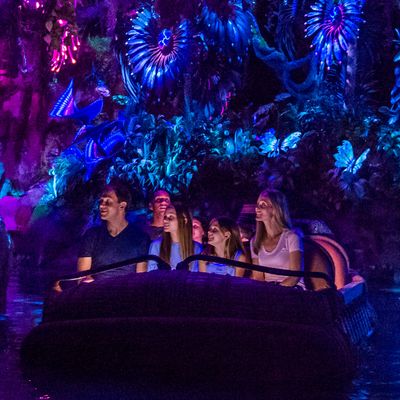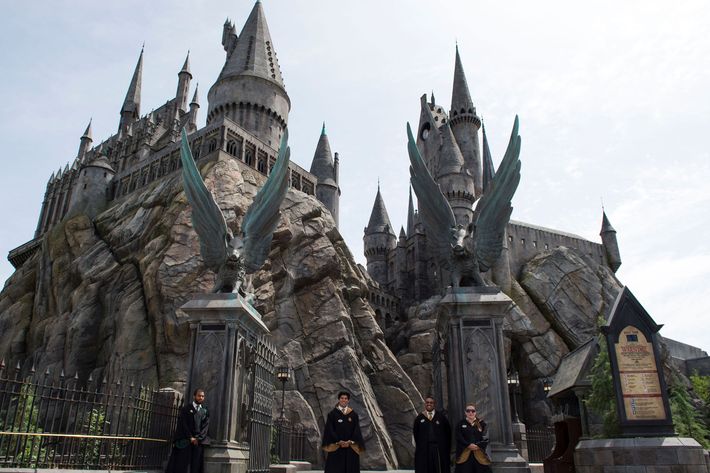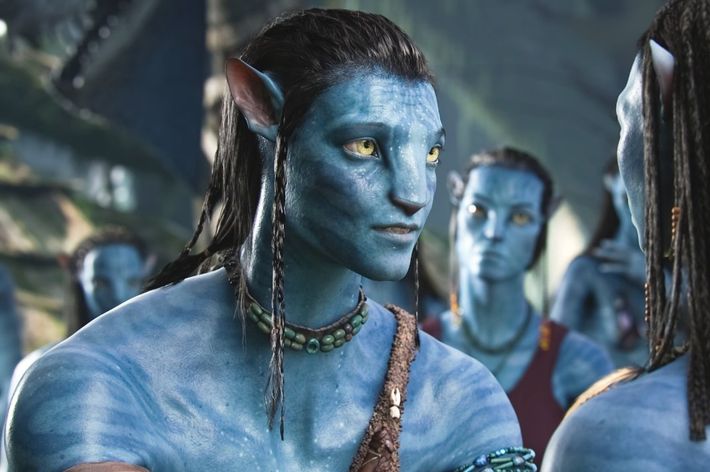
Stepping into Pandora — The World of Avatar, the sprawling, 12-acre land that just opened at Disney World’s Animal Kingdom — is, as the creators surely intended, like entering another planet. Strange plants sit next to ones that you sort of recognize. You can hear odd animals rustle in the underbrush. At night, a bioluminescent forest comes to life, bathing everything in an ethereal glow. Your footsteps light up as you walk. Everything, it seems, is alive.
And the attractions inside the land are just as immersive; the Na’vi River Journey lets you cruise through the planet’s wilderness and culminates in an animatronic Na’vi Shaman of Song. And on Flights of Passage, a 3-D ride that simulates riding one of the movie’s dragonlike banshees, you can actually feel the animal breathe beneath you.
There are a million questions that will race through your mind as you wander around Pandora, like how did they make the floating mountains actually float? Did you really hear different animals scuttling around and making different noises at different parts of the day? And if I’m on Pandora, an alien planet that symbolizes freedom from the ravages of capitalism, how am I still able to order a Coca-Cola?
But the biggest question you’ll probably ask yourself is why? Why did Disney, a company flush with recognizable brands like Star Wars and Marvel, spend more than a half-decade and hundreds of millions of dollars working with one of the most notoriously difficult filmmakers on the planet to create a land based on a movie that people rarely talk about and hardly remember?
The answer is a complicated one. But it has a lot to do with a certain boy wizard.
In 2003, Bob Gault, then-president of Universal Orlando, who had led the resort through the troubling, vacation-averse post-9/11 period, held a team meeting with hundreds of employees. At some point during the meeting, an employee stood up and asked Gault a question. The topic had turned to other properties that Universal had looked into adding to its theme park portfolio. “Has Universal pursued Lord of the Rings or Harry Potter?” the employee asked. “Disney has Harry Potter wrapped up. We will check into Lord of the Rings,” Gault answered.
The following year J.K. Rowling signed a letter-of-intent with Disney. Under the agreement, a small Potter-themed land would be built in the Magic Kingdom section of Disney World. Utilizing a space once occupied by an attraction based on 20,000 Leagues Under the Sea, the Potter section would feature a Care of Magical Creatures petting zoo, a Defense Against the Dark Arts ride, a retail component, and a quick-serve restaurant. Interestingly, this land would take no cues from the popular film series, which was then in full swing; instead, it would be based exclusively on Rowling’s books. Later in 2004, though, the Disney deal fell apart, supposedly because Rowling was unhappy with her level of involvement and felt unnecessarily marginalized.
In 2007 Universal Parks & Resorts publicly announced that they’d acquired the theme-park rights to Harry Potter film franchise. Harry Potter would be visiting Orlando after all, setting up residence at Islands of Adventure at Universal. Two years later, the company unveiled plans for the land, which would re-create the village of Hogsmeade and include a ride set in Hogwarts. When the Wizarding World of Harry Potter finally opened in 2010, it was, to put it mildly, a game changer.
Wizarding World was unlike anything theme park guests had ever experienced at time. The level of immersion was staggering, the detail overwhelming, and the technology truly next level. It wasn’t just going to a theme park for a day and getting on a ride that was vaguely tied to, say, Jurassic Park. No, fans stepped into the world of Harry Potter, got to choose a magic wand, take a photo in front of the Hogwarts Express, enter the castle where so many of Harry’s adventures unfolded, with an unprecedented level of fidelity to the source material. (Unlike Disney, Universal was adapting the films.) For the first time Universal wasn’t just doing Disney-quality work, they were exceeding that quality. They’d raised the bar, and made a healthy amount of galleons doing it. (The attraction’s $170 million construction costs were recovered in just five months, thanks largely to the runaway success of butterbeer.) The entire industry took notice of Potter’s success and innovation, including Disney.

Disney had a number of ambitious projects in the works when Wizarding World opened, including an expansion of the Fantasyland section of the Magic Kingdom in the same spot where their Harry Potter land would have gone, and a nearly complete redo of its Disney California Adventure park, which had struggled with attendance since it opened in 2001. The cornerstone of the DCA redo was Cars Land, an area themed to Pixar’s Cars films. It was in the spring of 2011, when Tom Staggs, who was then head of Parks & Resorts, was walking around the still-in-construction Cars Land that he hit upon the idea of bringing Avatar to Disney Parks. Staggs took the idea to CEO Bob Iger, and together they began talking with Avatar director James Cameron and producer Jon Landau. Initially proposed as part of Disney’s Hollywood Studios theme park, at the initial meeting, Staggs suggested something bigger. And if it’s anything Cameron responds to, it’s bigger.
In September 2011, Iger and Disney announced that Avatar would be coming to Animal Kingdom. In the original press release, Staggs suggested that construction on the first Pandora theme park would take five years, hinting that the move was done with an eye toward building more of them at the international parks. (Almost three-quarters of Avatar’s box office was earned overseas.) And while this announcement was a shock to the outside world, it was also a surprise to those internally, specifically at Walt Disney Imagineering, the arm of the company that designs and implements its theme-park attractions. They had no idea. (Full disclosure: I used to work for Disney, as a writer for Disney.com.)
Looking back on it, Staggs and Iger’s decision makes sense. With a whopping $2.8 billion in global box office, Avatar was and still is the all-time box-office champ. Using the kind of envelope-pushing technology that Walt Disney had always favored, Cameron had brought audiences something they’d never experienced before. And the filmmaker was bullish about following Avatar with sequels, announcing Avatar 2 and 3 for Christmas 2014 and 2015. By the time the land was open, the world would be deep in the throes of Avatar mania. And what’s more, given the movie’s extraordinary world-building — which everyone agreed was its main selling point — Disney would be able to create a truly immersive land. They’d finally have their Potter killer. In Iger and Staggs’s thinking, by the time the land opened, people would be dying to visit Pandora.
Except that didn’t exactly happen.
Cameron, notorious for being a filmmaker whose productions came in over budget and behind schedule (just look at the painful productions of The Abyss, Titanic, or, well, Avatar), announced in 2013 that, actually, there wouldn’t be two Avatar sequels; there would be three. But they would open in December 2016, 2017, and 2018. Around the same time, the second phase of the Wizarding World of Harry Potter, the even-more-ambitious Diagon Alley, opened to rave reviews, raising the stakes even more. But maybe the biggest thing to befall the company during that period was the 2012 announcement that Disney had acquired Lucasfilm, meaning that Disney now owned the rights to Star Wars, Indiana Jones, and a number of smaller properties. Suddenly the need to build a massive theme park based on a franchise that Disney didn’t actually own seemed unnecessary, especially when, in 2015, Iger announced the creation of massive Star Wars–themed lands for both Disneyland and Disney’s Hollywood Studios in Florida.
Meanwhile, those Avatar sequels were no closer to being completed, and the land itself was falling behind schedule; a new opening date of 2017 for Pandora — The World of Avatar was announced (in pencil).

A bigger problem, too, was that interest in Avatar had waned since its original, blockbuster debut. (After a number of delays, the first Avatar sequel is now scheduled for 2020.) In 2014, for the film’s five-year anniversary, Forbes published a piece about how Avatar had “left no cultural footprint whatsoever.” Two years later, BuzzFeed would publish a difficult quiz asking readers, “Do You Remember Anything At All About Avatar?” As the years between the announcement and the opening dragged on, Disney became increasingly concerned.
Last year, when I was still working for the interactive division of Disney, several people visited us from Disney Parks, to talk about Pandora – The World of Avatar. They had a problem, they told us. The team from the parks could tell that people were Googling “Pandora” and “Disney” but they couldn’t tell whether or not they were looking up the online radio station or the jewelry brand. (Disney has connections to both.) They needed to create definitive and sustained awareness and excitement for Pandora, which they hoped would finally open in the summer of 2017.
This kind of worry persisted. By the time Pandora opened to the public in May, it had been seven-and-a-half years since the movie opened. There would be kids visiting Walt Disney World who had never seen the movie, or didn’t even know it existed. In a recent article in the Orlando Sentinel, several top industry professionals expressed doubt about the viability of the project. “It’s surprising that Disney would pick a story with such little depth and build an entire land around it,” Scott Smith, assistant hospitality professor at the University of South Carolina, told the paper. Bob Boyd, a leisure analyst with Pacific Asset Management, said the land represented Disney “struggling” with how to respond to the Wizarding World of Harry Potter.
Making things somewhat difficult is the fact that the land’s internal story is set several decades after the events of the last Avatar sequel, which is an incredibly difficult thing to get across to your average theme-park visitor. Visitors who do have fond memories of Jake Sully and Neytiri won’t find them here; instead, they’ll be greeted by a bunch of new characters. This is a problem that the Wizarding World of Harry Potter, quite plainly, doesn’t have. “We’ve been really quite scrupulous about the fact you don’t need to know a thing in order to experience and enter the land,” senior Disney Imagineer Joe Rohde, who has overseen the construction of Pandora, told the Sentinel. “It is … meant to be understood emotionally, reacted to, navigated through and appreciated by a person who has absolutely no access to the pre-existing story.” Uh, okay.
Still, Disney has rallied. The opening of Pandora was deemed a “corporate priority,” which meant that every line of business was expected to support it in whatever way they could. There was an ad during this year’s Oscars and sustained support since. On one single day in March, Pandora-related material appeared on Good Morning America, The View, The Chew, and Nightline. Through soft openings and annual-pass previews Disney stoked excitement, particularly about the merchandise on sale, like a tiny banshee that sits on your shoulder and a Na’vi action figure that, thanks to facial-scanning technology, looks just like you. And while the company has been seemingly apprehensive about the land’s prospects, Disney has already earmarked two expansion plots for an additional attraction and an elaborately themed sit-down restaurant.
Pandora has just opened, and early attendance has been strong; it’s too soon at this point to conclusively declare whether it’s a total success or a near miss. At one point Pandora was seen as a key component to revitalizing the Animal Kingdom park, which has always fought to carve out a unique identity for itself amongst the constellation of parks in Disney World. But Disney, as always, is hedging its bets: The company is rumored to be planning a Zootopia attraction elsewhere in Animal Kingdom. At least the doodads are a hit — the tiny, remote-controlled banshees (miniature versions of the beasts you ride in Flights of Passage) have completely sold out.
Disney seems to have also learned something from the whole Avatar experience. Yes, Pandora is immersive and you can walk around endlessly getting lost in the floating mountains and glowing plant life, but that isn’t enough. In a way it feels like a response to what Universal was doing several years ago, and not to the needs and demands of parkgoers today. And as the rush to 2021’s 50th anniversary of Disney World approaches, and the rivalry with Universal, which is currently planning a Super Nintendo World, intensifies, Disney is going to have to up its game. Creating something beautiful from a property that people barely remember can’t cut it. Instead, Disney is planning on making something unforgettably real that takes inspiration from your favorite movies ever.
Which brings us back to the Star Wars–themed lands coming to both Disneyland and Walt Disney World. We already know that they will have cast members dressed up as characters from the galaxy far, far, away; dinner theater that will be literally out of this world; and attractions that will likely harness the very cutting edge of what Imagineering can create. (One sees you fleeing from the First Order, another has you taking control of the Millennium Falcon). At Star Wars Celebration, it was mentioned that the parks will have a way of tracking your adventures throughout the land, as if you’re in a video game. Further adding to the experience is the still-as-yet-unannounced Star Wars–themed hotel coming to the Walt Disney World version, which will offer guests an even deeper adventure; they’ll apparently be handed dossiers and assigned missions, similar to the recent Pirates Adventure Cruises at Disney World. Creating a land visitors will want to put on Instagram is all well and good, but letting them interact with that land in new and profound ways, that will change each time and offer unique and unparalleled challenges, well, that’s the goal. And besides, what’s a floating mountain compared to a Death Star?

